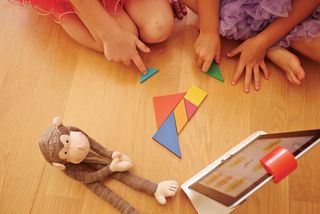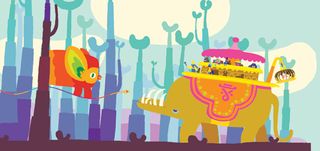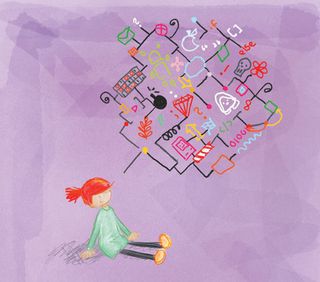How to use your design skills to tap a lucrative market
Robert Urquhart explains how to use your expertise to teach everything from tech to languages.
We live in an age where a job advert for a creative director in a digital agency requests an interest in 'social APIs, circuit boards and Arduino units' in order to 'understand how things talk to each other'.
The days of the garret – the untouchable talent in the ivory tower where smoke and mirrors abound – are over. For at least two years, ad agencies have been talking up a move towards product design; and when the slave turns master, you know something interesting is afoot.
The role of designer as mediator between technology and creativity is a natural one, but how best can designers equip themselves to prosper and fit within this hugely lucrative and growing sector of nuts-and-bolts technology? Education, as ever, is the answer.
Open-source creativity
The way we teach creativity and technology is being questioned in many quarters: programming is being seen not just as a language to be learned by rote, but a form of digital interaction that involves a high degree of interpersonal skill acquisition and free-flowing, non-conformist gaming.
For Pramod Sharma, engineer turned CEO of new games application Osmo, the inspiration for change in the way we see education and technology came from close to home.
"I have a five-year-old daughter, and the technology that she uses feels limited and anti-social. She sits there with her head bowed down, using her finger on a screen, so I thought: how do we solve this problem of interaction?"

Sharma's way of solving the problem was to put together a team built from similarly concerned 'young parents out of Stanford and Google' – engineers and game designers from Disney, LucasArts and Ubisoft – to create the Osmo, a device that promotes social intelligence and creative thinking.
Get the Creative Bloq Newsletter
Daily design news, reviews, how-tos and more, as picked by the editors.
Using crowdfunding and setting the bid price at $99 for everything you need to play the first three games, the Osmo kit, is billed as 'Apple meets Pixar sort of fun' according to Sharma.
He advises building experiences that are simple and intuitive: "With new trends, you start with something that's fun, engaging and easy for people to grasp" says Sharma. "That's why we started with games: people pick up games much quicker and are much more willing to try them. Also, lower the barrier of entry. Make it so intuitive that people want to be creative."
A lucrative path
There is space in the often gritty and hardcore world of computer graphics for a more sensitive and esoteric approach. Creating stories that allow for an open-ended, fail-forward, rough-and-ready approach could be an interesting and lucrative path for designers that have previously been put-off by slick, machismo graphics and bullish storyboards.
A prime example of a game that combines intuitive design with fun and a low entry point is Hohokum, a new release on Sony PlayStation 3 and 4 and PlayStation Vita from British independent video game developer Honeyslug, in collaboration with designer, artist and illustrator Richard Hogg.

Hohokum is almost an anti-shoot-'em-up, a whimsical journey into the unknown. There are few rules and plenty of scores that don't really matter.
Game developer Sony Santa Monica hired off-beat independent designers and programmers after witnessing a child playing the prototype at a trade show in Los Angeles: "The whole time they were there, there was a four-year-old boy who wouldn't get off the game," laughs Hogg. "What better advert can you get?"
Asked about where he sees graphic design and computer gaming heading, Hogg candidly responds that "if graphic designers like Geoff McFetridge got involved they'd make a fortune – anyone with a more contemporary graphic aesthetic would stand to win against the current competition out there."
Build-and-play
Linda Liukas, co-founder of Rails Girls, a non-profit volunteer community aimed at making technology more approachable for women, is currently writing a book for children, called Hello Ruby, on basic creative programming.
Liukas agrees that there needs to be more physical interaction with technology, but would like to see more emphasis on creation and less on curation; less click-and-play and more build-and-play.

By aiming Hello Ruby at five- to seven-year-olds who don't necessarily read or write yet, Liukas hopes to catch them early enough to normalise programming into the creative mix.
This dawn of a more colourful, exciting computing culture is already underway. The market for easily tangible, scalable and identifiable design processes that aid and abet our understanding of digital is a recurring need.
Taking the design knowledge from the analogue world and applying it in quasi-skeuomorphic fashion has been the trend, but we are now at the edge of something far more deep seated. Pushing the frontiers of creativity from within the machine equates to a solid and controllable business proposition.
Visual teaching
Taiwanese-born venture capital investor ShaoLan is the author of Chineasy, a book, website and app. ShaoLan's aim is to teach the world the Chinese language using building blocks of language.
"This methodology connects the learning journey – students start from recognising simple characters by appreciating beautiful illustrations. Once they recognise a few of them, they can start building many more characters and phrases," she explains.

What's the role of designer in education from a client's perspective? According to ShaoLan, who hired several illustrators for the project, including Noma Bar, designers are an indispensable part of the plan: "With more technologies available and as the penetration of smart devices continues, designers could make a huge social and economic impact in the education sector."
It stands to reason that design will continue to play an ever-increasing role within education, particularly when it comes to technology. The lines will continue to blur, but it works the other way around too: education will directly affect the way we produce creativity.
Creativity in education
It's in our interest to promote the simple building blocks of digital creativity to our children and for those seeking to teach language to harness the age-old wisdom of illustrators. But it will take time for education to shift towards the fast-paced world of technology.
Linda Liukas is optimistic about the role of creativity in education and points to designers leading the way. "Code is the 21st century literacy, and the need for people to speak the ABC of programming is imminent," she declares.
"Our world is increasingly run by software and we need more diversity in the people who are building it and teaching it. More importantly, writing software is about expression, creativity and practical application. And this is where designers really excel."
This 'practical application' is being carried along by the increasing use of open source design. It's the perfect vehicle for discovering and educating in a number of fields, as Alex Klein of computer kit manufacturer Kano is finding out.
Unlimited possibilities
The Kickstarter-crowdfunded Kano kit allows anyone to build a computer and make games, including features for the ever-popular Minecraft, and most importantly, it teaches creative programming skills. "We want a new generation to look at technology as something they can create, not just consume," explains Klein, echoing the ambitions expressed by Linda Liukas.
"Kano is the first computer kit designed for all – it's affordable, accessible, and fun. We want you building your own computer, tablet, smartphone or wearable."
When asked about where he sees the market for technology and education heading, Klein's straightforward response speaks volumes: "We're shipping 18,000 build-your-own-computer kits to 87 countries, for ages seven to 81. Oh, and Steve Wozniak bought one."
Words: Robert Urquhart
The full version of this article first appeared in Computer Arts issue 232, a design education special packed with insight, inspiration and behind-the-scenes access to the world's most exciting creative minds.

Thank you for reading 5 articles this month* Join now for unlimited access
Enjoy your first month for just £1 / $1 / €1
*Read 5 free articles per month without a subscription

Join now for unlimited access
Try first month for just £1 / $1 / €1
The Creative Bloq team is made up of a group of design fans, and has changed and evolved since Creative Bloq began back in 2012. The current website team consists of eight full-time members of staff: Editor Georgia Coggan, Deputy Editor Rosie Hilder, Ecommerce Editor Beren Neale, Senior News Editor Daniel Piper, Editor, Digital Art and 3D Ian Dean, Tech Reviews Editor Erlingur Einarsson, Ecommerce Writer Beth Nicholls and Staff Writer Natalie Fear, as well as a roster of freelancers from around the world. The ImagineFX magazine team also pitch in, ensuring that content from leading digital art publication ImagineFX is represented on Creative Bloq.
